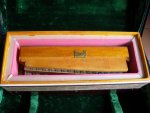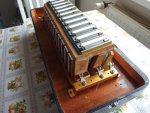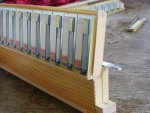I dont know if this has been posted before, but in doing a bit of research I have found some examples of non-standard bass reed block layouts.
You can find more pictures by searching for Winkelbass or winkelbaß (German: angled bass) on Google Images. I have also seen the term quasicassotto being mentioned.
I have not found much on this in English, but there are some discussions of it in German, especially on the this music forum: http://www.musiker-board.de/forum/
Here are some examples:
This one has all the bass reeds blocks at a 90 degree angle compared to the standard layout and mounted on a wooden box. It seems to have been in use at least during the war, possibly pre-war, based on the accordion it is in. Some more pictures here.
<ATTACHMENT filename=DSCN2157_Bass.JPG index=2>
This one is called Umlaufstimmstock (German: Circulation reed block). This kind has a bulkier reed block. Source
<ATTACHMENT filename=morinoivm_bassstock.png index=1>
This is the kind that seems to be called Winkelbaß primarily. Source
<ATTACHMENT filename=W2.jpg index=0>
Then I have also seen some (free bass) bayan and garmon (Russian accordions) where the reeds are mounted directly on the mounting plate/soundboard instead of in a reed block. Some of that might have been just for space restrictions and not necessarily for a specific sound change.
You can find more pictures by searching for Winkelbass or winkelbaß (German: angled bass) on Google Images. I have also seen the term quasicassotto being mentioned.
I have not found much on this in English, but there are some discussions of it in German, especially on the this music forum: http://www.musiker-board.de/forum/
Here are some examples:
This one has all the bass reeds blocks at a 90 degree angle compared to the standard layout and mounted on a wooden box. It seems to have been in use at least during the war, possibly pre-war, based on the accordion it is in. Some more pictures here.
<ATTACHMENT filename=DSCN2157_Bass.JPG index=2>
This one is called Umlaufstimmstock (German: Circulation reed block). This kind has a bulkier reed block. Source
<ATTACHMENT filename=morinoivm_bassstock.png index=1>
This is the kind that seems to be called Winkelbaß primarily. Source
<ATTACHMENT filename=W2.jpg index=0>
Then I have also seen some (free bass) bayan and garmon (Russian accordions) where the reeds are mounted directly on the mounting plate/soundboard instead of in a reed block. Some of that might have been just for space restrictions and not necessarily for a specific sound change.






